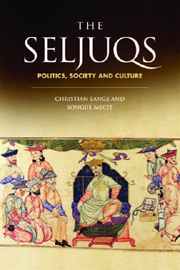Book contents
- Frontmatter
- Contents
- List of figures
- Acknowledgements
- List of abbreviations
- INTRODUCTION
- PART I POLITICS
- PART II SOCIETY
- 6 ARSLĀN ARGHŪN – NOMADIC REVIVAL?
- 7 CONTROLLING AND DEVELOPING BAGHDAD: CALIPHS, SULTANS AND THE BALANCE OF POWER IN THE ABBASID CAPITAL (MID-5TH/11TH TO LATE 6TH/12TH CENTURIES)
- 8 THE SELJUQS AND THE PUBLIC SPHERE IN THE PERIOD OF SUNNI REVIVALISM: THE VIEW FROM BAGHDAD
- 9 CHANGES IN THE OFFICE OF ḤISBA UNDER THE SELJUQS
- 10 AN EMBLEMATIC FAMILY OF SELJUQ IRAN: THE KHUJANDĪS OF ISFAHAN
- Part III CULTURE
- Index
6 - ARSLĀN ARGHŪN – NOMADIC REVIVAL?
from PART II - SOCIETY
Published online by Cambridge University Press: 12 September 2012
- Frontmatter
- Contents
- List of figures
- Acknowledgements
- List of abbreviations
- INTRODUCTION
- PART I POLITICS
- PART II SOCIETY
- 6 ARSLĀN ARGHŪN – NOMADIC REVIVAL?
- 7 CONTROLLING AND DEVELOPING BAGHDAD: CALIPHS, SULTANS AND THE BALANCE OF POWER IN THE ABBASID CAPITAL (MID-5TH/11TH TO LATE 6TH/12TH CENTURIES)
- 8 THE SELJUQS AND THE PUBLIC SPHERE IN THE PERIOD OF SUNNI REVIVALISM: THE VIEW FROM BAGHDAD
- 9 CHANGES IN THE OFFICE OF ḤISBA UNDER THE SELJUQS
- 10 AN EMBLEMATIC FAMILY OF SELJUQ IRAN: THE KHUJANDĪS OF ISFAHAN
- Part III CULTURE
- Index
Summary
Succession struggles in dynasties of Turkic or Mongolian stock are known to have been frequent and complicated: on principle, all male members of the ruling family had an equal right to rule. Many a time, the empire was divided up into appanages – territories where individual members of the dynasty ruled, often on a hereditary basis. The Seljuqs were no exception. Khurasan, the eastern Iranian region which had been the first basis of Seljuq power, seems to have been divided into a number of appanages by the end of the 5th/11th century, much to the disappointment of those who still thought that Khurasanis ought to stay in control of the Seljuq empire as a whole.
In this chapter, a succession struggle is the narrative background. The thesis is that pretenders for the throne were mobilising different sets of resources, above all of military manpower, and that the Turkmen (Ghuzz) warriors who had formed the backbone of the primordial Seljuq fighting force had by no means disappeared from the scene. The succession struggle also reveals political rifts within the empire. However, the last acts of the struggle were not staged because the hero disappeared in a kind of historical anticlimax.
When Malikshāh b. Alp Arslān died on 15 Shawwāl 485/20 November 1092, a number of Seljuq princes and also some other persons were eligible for his succession, or at least thought they might have a chance to win the sultanate.
- Type
- Chapter
- Information
- The SeljuqsPolitics, Society and Culture, pp. 99 - 116Publisher: Edinburgh University PressPrint publication year: 2011



